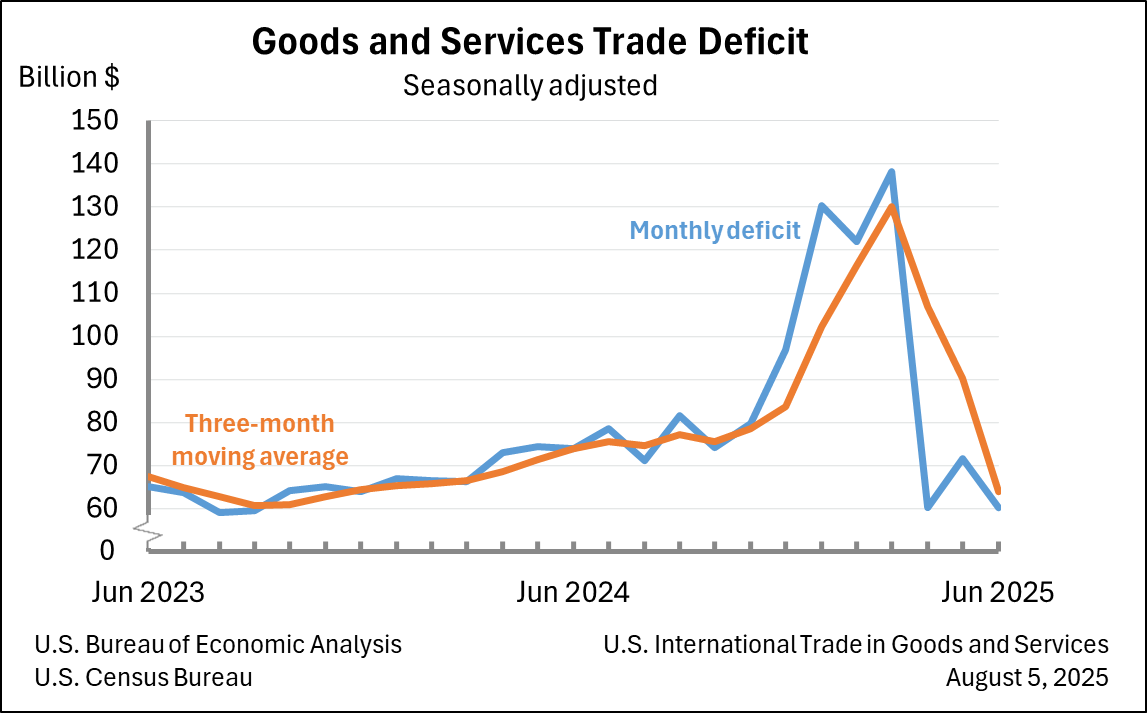Bureau of Economic Analysis
U.S. International Trade in Goods and Services, June 2025
The U.S. goods and services trade deficit decreased in June 2025 according to the U.S. Bureau of Economic Analysis and the U.S. Census Bureau. The deficit decreased from $71.7 billion in May (revised) to $60.2 billion in June, as exports decreased less than imports. The goods deficit decreased $11.4 billion in June to $85.9 billion. The services surplus increased $0.1 billion in June to $25.7 billion.
Principal Federal Economic Indicators
Noteworthy
- 2025 News Release Schedule
- Innovation at BEA
- 2025 Annual Updates
- New! Services Trade Data for More Countries
- Data Tool: Trade in Value Added
- Distribution of State Personal Income
- Updated: RIMS II Regional Multipliers
- Arts and Culture
- Space Economy
- FDI Now in State BEARFACTS
- Quick Guide: Price Indexes
The Latest
New Study Provides Profile of U.S. Firms that Export and Import Services
Data from the Bureau of Economic Analysis (BEA) show that the United States has historically maintained a trade surplus in private services. So what types of firms are involved in this kind of trade abroad? Thanks to a new BEA study we have a better understanding of the kinds of American companies that export and import services.
Here are some of the key findings:
Travel and Tourism Spending Increases
Inflation-adjusted spending on travel and tourism increased at an annual rate of 3.4 percent in the first three months of this year, the Bureau of Economic Analysis (BEA) reports. It had increased at a rate of 4.4 percent in the fourth quarter of 2011. The slightly slower pace in the first quarter mostly reflected less spending on air travel and on lodging.
Still, travel and tourism spending has grown faster than the U.S.…
Travel and Tourism Satellite Accounts, 1st quarter 2012
Real spending on travel and tourism increased at an annual rate of 3.4 percent in the first quarter of 2012 after increasing 4.4 percent (revised) in the fourth quarter of 2011. By comparison, growth in real gross domestic product (GDP) increased 1.9 percent (second estimate) in the first quarter after increasing 3.0 percent in the fourth quarter. The increase in real spending on tourism primarily reflected increases in traveler…
Current-Account Deficit Increases in First Quarter
The U.S. current-account deficit—the combined balances on trade in goods and services, income, and net unilateral current transfers—increased to $137.3 billion (preliminary) in the first quarter of 2012 from $118.7 billion (revised) in the fourth quarter of 2011. As a percentage of U.S. gross domestic product, the deficit increased to 3.6 percent from 3.1 percent. The previously published current-account deficit for the fourth quarter was $…
U.S. International Transactions, 1st quarter 2012
NOTE: See the navigation bar at the right side of the news release text for links to data tables, contact personnel and their telephone numbers, and supplementary materials.
Sarah P. Scott: (202) 606-9286 (Data) Paul W. Farello: (202) 606-9561 (…
What is the Value of Household Work?
The Nobel Prize winner Simon Kuznets presented an original set of estimates to Congress in 1934 that contained a number of caveats about what was omitted from the calculation of national income (and later from the calculation of gross domestic product) that made it an imperfect measure of welfare.
April Trade Gap is $50.1 Billion
The U.S. monthly international trade deficit decreased in April 2012, according to the U.S. Bureau of Economic Analysis and the U.S. Census Bureau. The deficit decreased from $52.6 billion (revised) in March to $50.1 billion in April, as imports decreased more than exports. The previously published March deficit was $51.8 billion. The goods deficit decreased $2.7 billion from March to $64.8 billion in April, and the services surplus decreased…
U.S. International Trade in Goods and Services, April 2012 U.S. International Trade in Goods and Services, 2011 annual revision
-->
Widespread State Economic Growth in 2011
Real GDP increased in 43 states and the District of Columbia in 2011. Leading industry contributors were durable-goods manufacturing; professional, scientific, and technical services; and information services.
Durable-goods manufacturing was the leading contributor to real GDP growth in 26 states, contributing 3.94 percentage points to growth in Oregon and 1.17 percentage points to growth in Michigan.
Gross Domestic Product by State, 2011 (advance estimate) and 1997-2010 (revised estimate)
EMBARGOED UNTIL RELEASE AT 8:30 A.M. EDT, TUESDAY, JUNE 5, 2012




